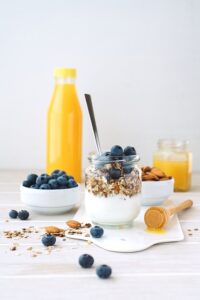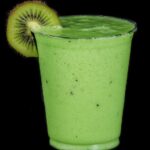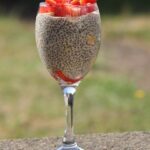So Are Smoothies Made with Milk Alone ?
Understanding Smoothies: The Role of Milk
Did you know that over 80% of Americans consume smoothies regularly? These vibrant, nutritious beverages have taken the culinary world by storm, often touted for their health benefits and convenience. But a common question arises: Are smoothies made with milk?
Are Smoothies Made With Milk?
The versatility of smoothies allows them to be crafted from a variety of ingredients. Milk is a popular choice, providing a creamy texture and rich flavor that many enjoy. However, it’s essential to understand the role milk plays in these blended drinks and how it can impact their nutritional profile.
In this article, we’ll uncover the different types of milk used in smoothies, the health benefits of incorporating milk, and alternatives for those who prefer to skip it. Get ready to blend your curiosity with delicious knowledge as we dive into the world of smoothies!

The Basics of Smoothies
Smoothies have become a staple in the diet of health-conscious individuals and food enthusiasts, but what exactly defines this beverage? At its core, a smoothie is a thick, creamy drink that’s typically made by blending fruits, vegetables, and liquids. The result is a delightful concoction that not only tastes delicious but can also be tailored to meet personal health goals.
Key Ingredients of a Smoothie
The magic of smoothies lies in their versatility. While there are countless variations, most smoothies include the following core ingredients:
Texture and Consistency
One of the defining characteristics of a smoothie is its creamy consistency. This texture can vary based on the specific ingredients used:
For instance, a smoothie with a banana and spinach base blended with almond milk will yield a creamy consistency that’s easy to sip, while a mix of frozen berries with a splash of coconut water can deliver a fresher, more runny drink.
Popular Smoothie Trends
Smoothie culture has also embraced global flavors and trends. Matcha, acai, and even savory smoothies are making waves in contemporary recipes, appealing to adventurous eaters. Many health enthusiasts enjoy creating “smoothie bowls,” which are thicker than standard smoothies and topped with a variety of ingredients like granola, seeds, and fresh fruits, inviting a more interactive dining experience.
These delicious blends are not just whimsically crafted drinks; they offer nutritional benefits as well, especially when milk or dairy alternatives are involved. In the following section, we’ll delve deeper into the different types of milk used in smoothies and how they can affect both texture and nutrition, adding an extra dimension to these delightful drinks.
Types of Milk Used in Smoothies
When it comes to creating the perfect smoothie, the type of milk you choose can play a significant role in both flavor and nutrition. The options are vast, spanning traditional dairy varieties to innovative non-dairy alternatives. Let’s have a look at the types of milk commonly used in smoothies, highlighting their unique benefits and flavor profiles.
Dairy Milk: The Classic Choice
Whole Milk: A favorite for its rich and creamy texture, whole milk adds a velvety consistency that many smoothie enthusiasts crave. It provides essential vitamins like A and D, along with calcium and protein, fueling your body effectively.
Skim Milk: For those looking to lighten their smoothies without sacrificing flavor, skim milk offers a great alternative. It retains the protein and calcium levels of whole milk while cutting out extra fat, making it a popular choice among health-conscious drinkers.
Flavored Milk: Chocolate or strawberry milk can add a fun twist to your smoothies, especially for kids or anyone with a sweet tooth. These flavored options serve as a delightful base for smoothies, adding a touch of sweetness and an extra layer of flavor.
Non-Dairy Alternatives: For Every Preference
Almond Milk: Light and subtly nutty, almond milk is often chosen for its low-calorie count and vegan-friendly status. It’s a fantastic option for those seeking a nut-based alternative, perfect for pairing with fruits like bananas and berries.
Soy Milk: High in protein, soy milk is another popular non-dairy choice that closely mimics the thickness of cow’s milk. Its creamy texture makes it an excellent base for smoothies packed with fruits and vegetables, providing substantial nutrition for plant-based diets.
Oat Milk: Gaining popularity in recent years, oat milk boasts a mild, slightly sweet flavor. Its naturally creamy texture stands up well in smoothies, making it ideal for those with nut allergies. It’s particularly delicious when combined with spices like cinnamon or chai.
Coconut Milk: For a taste of the tropics, coconut milk can take your smoothies to the next level. Rich in flavor and creamy consistency, it works beautifully with tropical fruits like mango and pineapple. Additionally, its medium-chain fatty acids may provide some metabolic benefits.
Versatile Blending Options
Many smoothie aficionados enjoy experimenting with combinations of different types of milk. Mixing almond and coconut milk, for instance, can create a rich profile that enhances both texture and flavor. Additionally, using unsweetened varieties of these milks helps control sugar content, allowing for smoother blending of other taste elements.
As you consider your options for crafting the ultimate smoothie, understanding the flavor and nutritional profiles of various milk types is essential. Next, we’ll delve into the nutritional benefits of incorporating milk into your smoothies, exploring how different choices can impact your overall health and well-being.
Nutritional Benefits of Adding Milk to Smoothies
In this pursuit of crafting the perfect smoothie, it’s essential to consider the nutritional benefits that milk can bring to the mix. When you blend milk into your favorite fruit and veggie concoctions, you not only enhance the texture and flavor but also enrich your smoothie with essential nutrients that contribute to a well-rounded diet.
Calcium: A Strong Foundation
Milk is renowned for being a rich source of calcium, a vital mineral for maintaining strong bones and teeth. Just one cup of whole milk provides about 276 mg of calcium, approximately 27% of the recommended daily intake for adults. This nutrient is particularly crucial for growing children and active adults engaged in sports or fitness, as it supports bone health in developing skeletons and helps prevent bone loss in later years.
Protein Power
In addition to calcium, milk is an excellent source of high-quality protein, which is crucial for muscle repair and growth. A standard cup of skim milk contains around 8 grams of protein. This additional protein can enhance the satiety of your smoothie, making it a more satisfying meal or snack option. Whether you’re recovering from a workout or simply looking for a filling breakfast, a smoothie with milk can keep hunger at bay for longer.
Vitamins A and D
Milk is fortified with vitamin D, which is essential for calcium absorption and supports overall immune function. Coupled with vitamin A, which promotes good vision and skin health, including milk in your smoothie can make a significant positive difference in your daily nutrient intake. These vitamins are especially beneficial during the darker months or for individuals with limited sun exposure, ensuring your body still receives what it needs.
Contributing to Daily Nutrient Intake
For those following dietary guidelines that recommend increased fluid intake, smoothies serve as a fun way to include more liquids in your day. Adding milk not only satisfies this requirement but can also help meet your daily needs for several key nutrients. The combination of fruits and milk makes it easy to hit several targets in one go, making your meal planning a breeze.
A Quick Tip: Flavor Enhancements
To really level up the nutritional content of your milk-based smoothies, consider adding extras such as spinach or kale, which pair beautifully with milk and offer additional vitamins and minerals. Chia seeds or flaxseeds can also provide healthy omega-3 fatty acids, promoting heart health alongside the benefits of protein and calcium.
As we can see, milk not only enhances the flavor of smoothies but also significantly boosts their nutritional profile. For those still exploring their options, the next section will introduce various alternatives to traditional milk in smoothies, perfect for those with dietary restrictions or personal preferences.
Alternatives to Milk in Smoothies
While milk is a popular and nutritious choice for many smoothie enthusiasts, it’s not the only option out there. You may choose to avoid milk due to lactose intolerance, dietary preferences, or simply a desire to explore different flavors. Fortunately, there is a wealth of alternatives that can serve as a base for your smoothie without compromising on taste or nutrition.
Water: The Simplest Base
For those looking to keep it light and refreshing, water can be an excellent choice. Using water creates a more hydrating smoothie, making it easier to sip on a warm day. Adding ice can enhance the texture, combining the benefits of low-calorie consumption with a cool, invigorating experience. For a hint of flavor, consider infusing your water with herbs like mint or basil before blending.
Juice: A Sweet Addition
Fruit juices, like orange, apple, or grape, can add a delightful sweetness to your smoothie. While juices provide a burst of flavor and hydration, they also come with a higher sugar content, so it’s best to opt for 100% fruit juice without added sugars. A splash of juice paired with some leafy greens can create a vibrant, nutrient-rich blend—think the tartness of cranberry juice mixed with tangy spinach for an energizing drink.
Yogurt: Creamy and Probiotic
Greek yogurt or other non-dairy yogurts can add a creamy texture while also boosting protein levels. This option is especially popular among those looking to create smoothies that double as meal replacements. Not only does yogurt contribute a rich, tangy flavor, but it also introduces probiotics, which promote gut health. Blending yogurt with fruits like strawberries or blueberries creates a smooth and satisfying treat that’s both delicious and nutritious.
Nut Milks: Vegan and Diverse
Nut-based milks, such as almond, cashew, and macadamia, offer a varied taste experience without dairy. Almond milk, for example, has a lighter consistency, while cashew milk brings a creamier profile to the mix. These options are generally lower in calories than whole milk and are fortified with vitamins and minerals, making them a nutritious choice for smoothie base. Combining almond milk with a banana and spinach creates a delightful blend that’s both healthy and satisfying.
Seed Milks: A New Frontier
In recent years, seed milks like hemp or pumpkin seed milk have gained popularity as alternative bases for smoothies. These milks provide healthy fats, protein, and minerals such as magnesium. Their unique flavors can lend surprising depth to your smoothie recipes. For example, pumpkin seed milk combined with banana and cocoa powder offers a delicious, nutrient-packed treat that’s sure to please.
As you explore these alternatives, remember that each base can significantly alter your smoothie’s taste and texture. Get creative and experiment with combinations to find the perfect match for your palate! So now, are smoothies made with milk? Well next, we’ll dive into popular smoothie recipes that feature both milk and non-milk bases, allowing you to try out some tasty blends tailored to your preferences.
Popular Smoothie Recipes with and without Milk
Smoothies offer a delightful way to enjoy a blend of flavors, textures, and nutritional benefits, whether you choose to incorporate milk or experiment with various alternatives. Below, we’ve categorized a selection of popular smoothie recipes that either include milk or rely on alternative bases, catering to diverse tastes and dietary needs.
Smoothies with Milk
1. Classic Strawberry Banana Milkshake Smoothie
Ingredients:
Instructions:
Blend all ingredients until smooth. This creamy smoothie provides a delicious source of calcium and vitamins while satisfying sweet cravings.
2. Green Protein Power Smoothie
Ingredients:
Instructions:
Combine in a blender and blend until well-mixed. The almond milk provides a subtle nutty flavor while the protein powder boosts nutritional intake, perfect for post-workout recovery.
3. Chocolate Peanut Butter Dream
Ingredients:
Instructions:
Blend until creamy. This decadent treat offers a delightful mix of flavors while delivering protein and a chocolate fix without the guilt.
Smoothies without Milk
4. Tropical Mango Pineapple Bliss
Ingredients:
Instructions:
Blend until silky smooth. The coconut water provides a refreshing hydration boost, making it perfect for hot days.
5. Berry-Acai Antioxidant Smoothie
Ingredients:
Instructions:
Blend thoroughly and enjoy this colorful, nutrient-packed smoothie that’s bursting with antioxidants and excellent for your skin!
6. Creamy Avocado Green Smoothie
Ingredients:
Instructions:
Blend until smooth. Avocado provides creaminess without any dairy, along with healthy fats that are great for heart health.
Mixing It Up!
Feel free to mix and match ingredients from these recipes to suit your preferences. Perhaps swap coconut water for almond milk in the Tropical Mango Pineapple Bliss, or add protein powder to the Berry-Acai Antioxidant Smoothie for an extra boost. The versatility of smoothies allows for endless combinations tailored to individual tastes and dietary needs.
As you explore these flavorful blends, consider how easily you can personalize each recipe to make it uniquely yours. Now that you have a taste of some delicious options, let’s wrap up by considering the role of milk in smoothies and how it fits into your overall lifestyle.
Final Thoughts on Milk in Smoothies
In summary, the decision to include milk in your smoothie ultimately hinges on personal preference and dietary requirements. So, are smoothies made with milk? While traditional dairy milk offers a creamy texture and additional protein, there are also a variety of plant-based milks that can cater to those who avoid dairy or seek alternative nutrition sources. Each option brings its own unique flavors and health benefits to the table.
As you experiment with smoothie recipes, consider your own taste and nutritional goals. Whether you choose to blend with milk or opt for a dairy-free alternative, the key is to create a delicious and satisfying drink that complements your lifestyle. Enjoy the journey of discovering what works best for you!






